Back in April 2022, we were quick to jump on Elon Musk’s interest in Twitter and created an article covering the news and implications of Musk’s takeover. We made a lot of predictions about what could happen as a result of such a takeover. It has now been over a year, and a lot has changed. In this article, we will look at the history of Twitter, and cover its transformation into ‘X’ (‘Twitter X‘). We’ll explore the uncertain future of Twitter under Elon Musk and look at what this means. Will it cause the eventual decline and death of Twitter? Or will this the social media giant rise like a phoenix?

Twitter X – Elon Musk’s “everything app”
Editor’s Note [14th November 2023]: We’ve made a small refresh to our article titled ‘The Death of Twitter or Rise of the Phoenix? History, Decline & Uncertain Future of Twitter X Under Elon Musk’ dated 1st September 2023 to include new information, including Musk’s AI addition to X called Grok.
The History of Twitter
-
1
The History of Twitter
- 1.1 Twitter Timeline Video – From ‘twttr’ in 2006 to ‘X’ in 2023 and Beyond
- 1.2 Twitter’s History, Origins and Founders
- 1.3 Vision For Short-Form and Microblogging
- 1.4 Key Features, Innovation and Growth
- 1.5 Hashtags
- 1.6 Growth and Popularity
- 1.7 Twitter Blue Tick
- 1.8 Twitter Revamp of 2010
- 1.9 Platform Challenges
- 1.10 Twitter Monetisation
- 1.11 Twitter Controversy
- 1.12 Bot Accounts
- 1.13 Twitter Censorship
- 1.14 Competition from Trump’s Truth Social, Meta’s Threads, and Others
- 1.15 Reflecting on Twitter’s Journey
-
2
Twitter X & The Future of Twitter Under Elon Musk
- 2.1 Staff lay-offs
- 2.2 Platform Evolution
- 2.3 Twitter Blue
- 2.4 Twitter Premium vs Free – The Differences
- 2.5 Twitter Long-Form Content
- 2.6 Twitter X Rebranding & The Implications
- 2.7 Elon Musk’s Everything App (X App)
- 2.8 Musk of All Trades, Master Of None?
- 2.9 Challenges for Elon Musk
- 2.10 Ownership and Direction
- 2.11 X Subscriptions Feature
- 2.12 X’s Answer to AI, Grok
- 2.13 The Growth of Twitter
- 2.14 The Decline of Twitter
- 2.15 Worst Case Scenario For X (Decline & Eventual Death of Twitter)
- 2.16 Best Case Scenario For X (Twitter X Overtakes Facebook)
- 3 Conclusion
Twitter recently became X (aka Twitter X) after being rebranded by Elon Musk. Before diving into the implications of this, let’s take a look back at the history of Twitter in the lead-up to its transformation into X. Along with the associated successes and failures of the social network, we’ll look to the past while seeing how things look for the future of the platform with Musk at the helm.
Twitter Timeline Video – From ‘twttr’ in 2006 to ‘X’ in 2023 and Beyond
For a quick overview, we’ve put together a brief Twitter history and timeline video. The video highlights the key events from Twitter’s inception to the present and ends with our predictions on what might lie ahead for ‘X’ in the years 2023-2025.
Twitter’s History, Origins and Founders
Twitter was created in March 2006 and was founded by Jack Dorsey, Biz Stone, Noah Glass and Evan Williams. Evan and Biz benefited from their previous experience working for Google in the years prior, which no doubt helped in the creation of the platform.
The initial concept for Twitter came from Jack Dorsey, who conceptualised a service that could share text messages (SMS) with a small group of people. This was likely influenced by Evan’s prior projects at Google that eventually led to the creation of Blogger. The first tweet was sent on the 21st March 2006 by Jack Dorsey. This tweet later went up for sale as an NFT in 2022 for $48 million, which ended with a top bid of just $280.
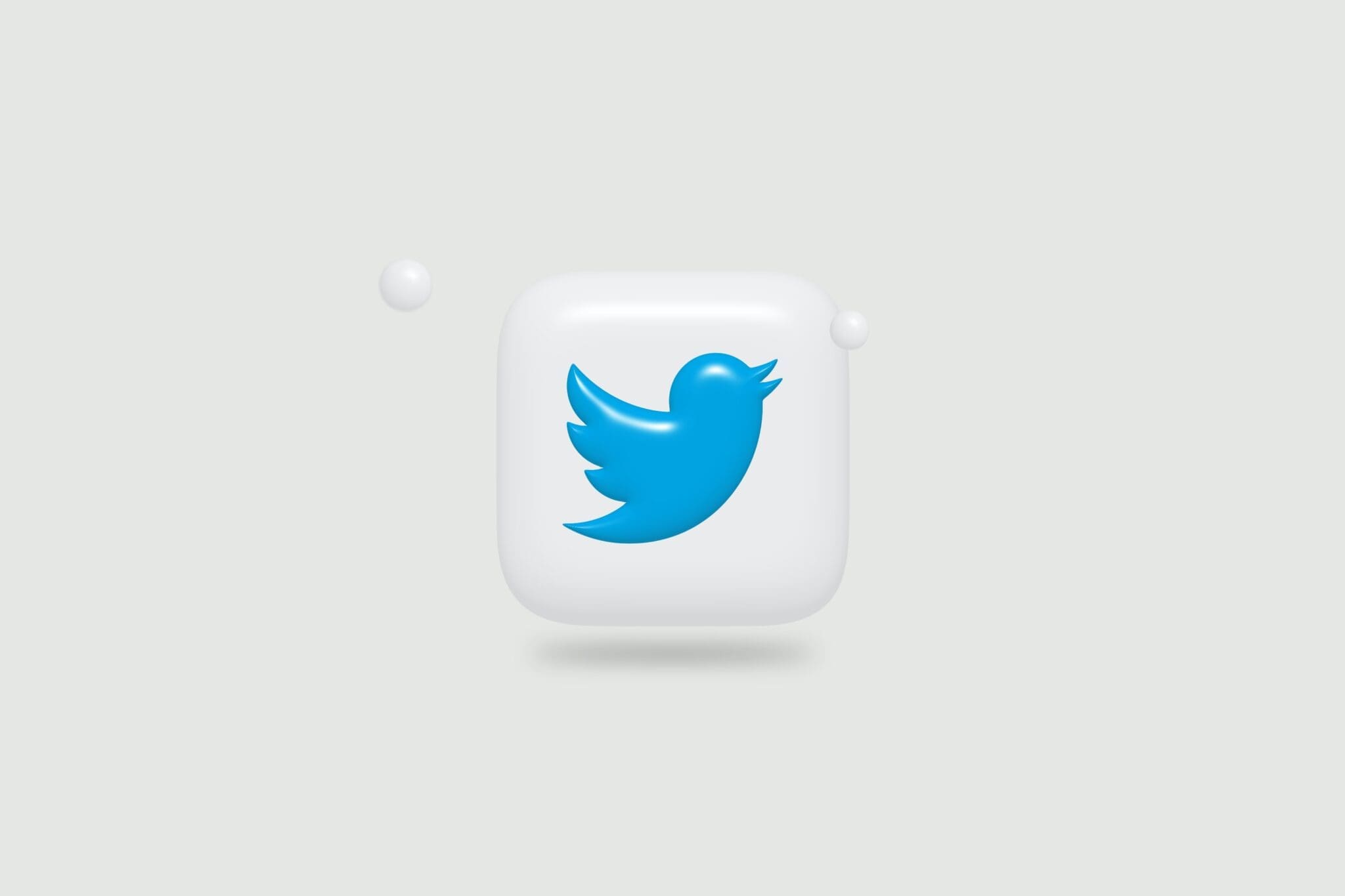
History & Future of Twitter Under Elon Musk – Photo by Sunny Hassan on Unsplash
Vision For Short-Form and Microblogging
The vision for Twitter, which was called twttr initially, was to create a short message service that could also function like a microblogging service. The concept was to allow users to share these updates with each other on a small scale (sharing updates with a small group of users).
The original character limit of Twitter’s updates was just 140 characters. This was both praised and criticised by various users. Some said that the limit didn’t feel long enough, while others said that it made tweets more concise. This was a bone of contention throughout the early years of Twitter’s life.
Key Features, Innovation and Growth
Throughout its lifespan, Twitter has created some fantastic features that many other platforms have since tried to replicate and reproduce. Let’s take a look at some of the features most synonymous with Twitter.
When you think of hashtags, you’ll probably instantly think of various trending social media topics. But did you know that hashtags first found common utilisation on social networks via Twitter?
The issue Twitter had at the beginning of its life was the categorisation and discoverability of tweets. Despite the short character limit, tweets were often still blocks of uncategorised text that was hard for other users to discover via a search.
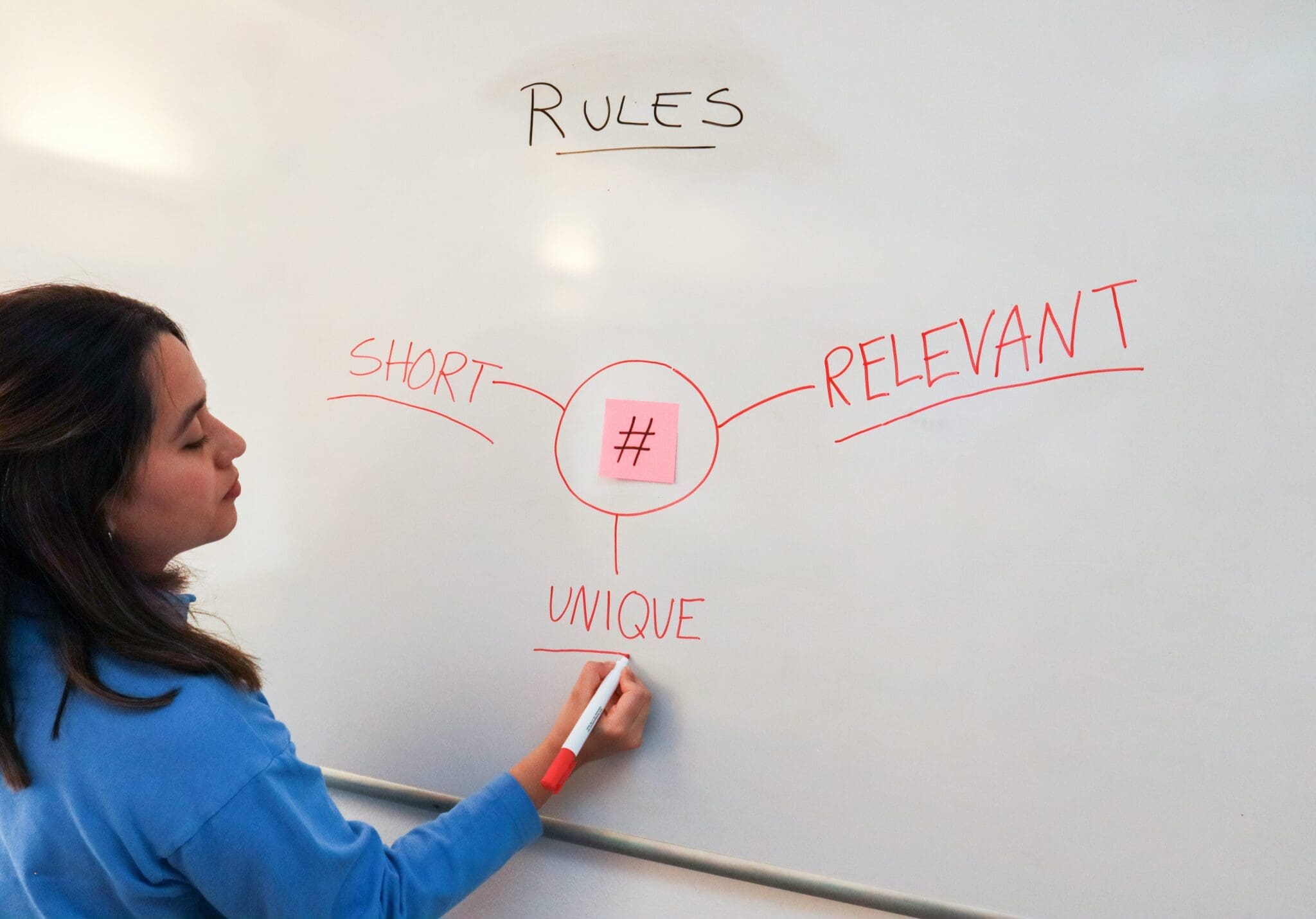
Defining The Rules At The Beginning of Twitter’s Life – Photo by Walls.io on Unsplash
This is where hashtags proved to be invaluable in the success of Twitter as a social media platform. Surprisingly, Twitter themselves didn’t really like the idea of hashtags at the start going as far as calling them “too nerdy”.
A Twitter user named Chris Messina first came up with the idea in 2007, originally suggesting the use of the ‘£’ character in order to filter subjects by topic. This was met with disinterest and a lot of mixed feelings from users of the platform, but later on ended up being an essential standard that nearly all of the major social networks utilise.
Growth and Popularity
The first major event that kickstarted Twitter’s popularity was the South by Southwest Interactive conference (SXSWi) where dedicated screens were mounted to the walls to display new tweets relating to the event. As a result, Twitter usage had increased from an average of 20,000 tweets per day to 60,000. The platform continued to gain traction through word of mouth, and users who wanted to be kept informed at events or informed regarding global news.
In 2009, Twitter won a Webby Award, and later was declared ‘word of the year’ by Global Language Monitor, which praised the platform as providing a “new form of social interaction”. A short time after, the platform was reportedly facilitating over 50 million tweets per day.
In the years that followed, Twitter soared to new heights, largely driven by its role as the perfect platform for sports and popular event coverage. Users were able to stay consistently connected to the latest updates and news covering a wide range of topics from around the world.
Twitter Blue Tick
As Twitter gained popularity and adoption from more public figures and celebrities, there became an issue with impersonation which eventually resulted in the platform being sued for hosting unauthorised accounts. This is what led to Twitter’s verified accounts feature being created.
Twitter then used a blue ‘verified’ tick on profiles in order to verify that the account was legitimate and authentic. This was essential if the platform was going to be taken seriously by governments and public figures so was welcomed by many prominent accounts on the platform.
Twitter Revamp of 2010
In 2010, Twitter implemented a revamp which allowed rich media to be better integrated with the network. This also came with better integration of third-party content containing links to videos from sites such as YouTube. There were also a number of interface changes and improvements that generally improved the experience for users, and addressed some common complaints pertaining to platform navigation.
Shortly after, Twitter introduced the ‘Discover’ tab, which, as the name suggests, helped greatly with the discoverability of conversations on the platform. Twitter continued to update the platform and iterate on features and designs slightly to address the remaining complaints that many users had reported.
After these improvements had been implemented and any bugs ironed out, Twitter announced in 2012 that it had 140 million users, sending 340 million tweets per day.
Platform Challenges
Despite the huge success of the platform, it wasn’t all smooth sailing for Twitter for a multitude of reasons. Let’s dive into some of the issues that Twitter has had over the years, and identify which ones are still ongoing.
Twitter Monetisation
Despite its surging popularity, Twitter has seemingly always struggled with making money as a business. It took the platform until the first quarter of 2017 to make a profit. As the platform has been completely free to use for individuals and businesses since the start, Twitter has struggled to find a reliable and robust monetisation method.
Twitter eventually started making money by allowing advertisements, which accounted for over 85% of the annual revenue for the company. However, many advertisers left the platform once it was revealed that Elon Musk would be buying the company.
Twitter Controversy
In addition to its successes, the platform has had many controversies over the years — both in terms of the content and the way that the company is run. Let’s highlight a few of the most common controversies and long-standing issues the platform has experienced.
Bot Accounts
A point of contention that was raised during the finalisation of Musk’s Twitter deal was the number of bot accounts present on the network. This was problematic for Musk as the (at the time) potential new owner of the platform and even caused him to consider backing out. This is due to the accuracy of the data representing active users being called into question if many accounts were bots. The worry was that the numbers that Twitter boasted for tweets sent and active accounts were artificially inflated due to the platform’s bot problem.
Fake accounts (known as bot accounts) are accounts that automatically tweet from external news sources, upvote or retweet content, or just run automated promotions. These bot accounts can also take on more nefarious usage such as scams, influencing elections, and even swaying public opinion by modifying the perception of general consensus online. These bots can sometimes be used as part of larger Astroturfing campaigns.
Twitter Censorship
As sensibilities are completely different to that of the early 2000s, Twitter had proactively moved to make their platform a safer space for all groups of people with various backgrounds and beliefs. This sounds great on paper, but it ended up being a point of contention for many users on the platform.
The argument a lot of anti-censorship groups and individuals made is that there’s a difference between hate speech, and speech that you hate. Others disagreed and thought that those with harmful and offensive beliefs and values shouldn’t be welcome on the platform broadcasting their values to other impressionable users.
This came to a head in 2021 when the President of the United States at the time, Donald Trump, had his account permanently banned from the platform (@realDonaldTrump has since been reinstated). The main clash of opinion here came from one side declaring that the leader of the free world shouldn’t be silenced, and the other insisting that Twitter being a private company had the power and right to do what they wanted in regards to blocking what they deem to be harmful voices.
This is where the line blurs between business, politics and free speech.
Twitter decided to take a heavy-handed approach to censorship throughout the COVID-19 pandemic, along with the other big social media platforms such as Facebook and YouTube. In some cases, if opinions via tweets or videos were released that didn’t coincide with the WHO guidelines, the account in question risked suspension or termination. This is particularly problematic looking back with hindsight as the WHO guidelines were constantly changing, and in some cases ended up changing to coincide with individuals that were once banned for their stance of lockdowns or vaccines.
Whichever side of the fence you stand, this should be a lesson for future technology companies in terms of the dangers of censorship.
As a result of the heavy censorship taking place on Twitter, many new social media platforms were created, galvanised by the notion of protecting free speech and housing those who either left Twitter out of principle or were banned from the platform for their viewpoints.
One such platform was Donald Trump’s Truth Social which supposedly puts free speech at the centre of its core principles. However, there have been many reports of censorship on this platform too.
Platforms with similar functionality have been widely criticised for links to far-right and right-wing extremism showing just how hard it is to get the balance right. It seems like you’re either pro-censorship with little care towards free speech or far-right conservatives with their emphasis on free speech irrespective of who gets hurt in the process. Who’s right? There seems to be a need for a middle ground and nuance in the process that is currently missing from most social media conversations. This is where again the lines blur regarding technology, social media, and politics.
Other platforms such as Meta’s Threads have also become a serious competitor to Twitter. However, this was after Musk’s takeover, so we will address this later in the article.
Reflecting on Twitter’s Journey
Reflecting on Twitter’s history and journey from its humble origins in 2006 to the global communication powerhouse it is today, Twitter’s story is nothing short of captivating. The history of Twitter is sprinkled with transformations, including the introduction of the blue tick verified accounts, platform revamps, and paid advertising. These changes have played a crucial role in attracting Twitter’s massive user base, with the platform hosting over 140 million users sending 340 million tweets per day by 2012. All of that said, none of the changes come close to what’s in store for Twitter’s future under Elon Musk as ‘X’.
Twitter X & The Future of Twitter Under Elon Musk
Now that we’ve covered the history of Twitter, let’s jump into the future of Twitter X.
Part of the justification for Musk acquiring the platform came from the mass censorship and silencing of conservative voices. He aims to turn Twitter into a “public town square” removing much of the censorship that plagued the platform in favour of civil discourse and conversation.
Then in October 2022, Musk completed his acquisition of Twitter and became CEO.
Staff lay-offs
In April 2023, Musk admitted to the BBC that staff at Twitter had been cut down from around 8,000 to 1,5000 and that the company was “roughly breaking even”.
Musk commented:
Running Twitter has been “quite painful” and “a rollercoaster”
The result of letting staff go in an attempt to save money ended up being quite costly for the platform in terms of the consequences. There have been many technical problems, site crashes, and general downtime through the initial turbulent stage of the takeover. Many users questioned whether Musk had gone too far in letting such a huge number of essential staff go, worrying that it could jeopardise the technical stability and general security of the platform.
Platform Evolution
Despite Musk’s takeover happening several months ago, a large number of significant changes have already taken place. Let’s take a look at the most significant changes that have happened so far since Musk’s acquisition.
Twitter Blue
As we covered earlier in the article, Twitter had originally introduced the verification badge to stop impersonators and authenticate accounts so that other users knew they were legitimate and authentic. Over time, however, it felt as if it became more of a status symbol rather than a badge to authenticate a profile. Previously if you weren’t a large brand or well-known influencer, it was difficult to acquire the badge. Musk wanted to allow for more people to gain access to verification, and also increase revenue for the platform.
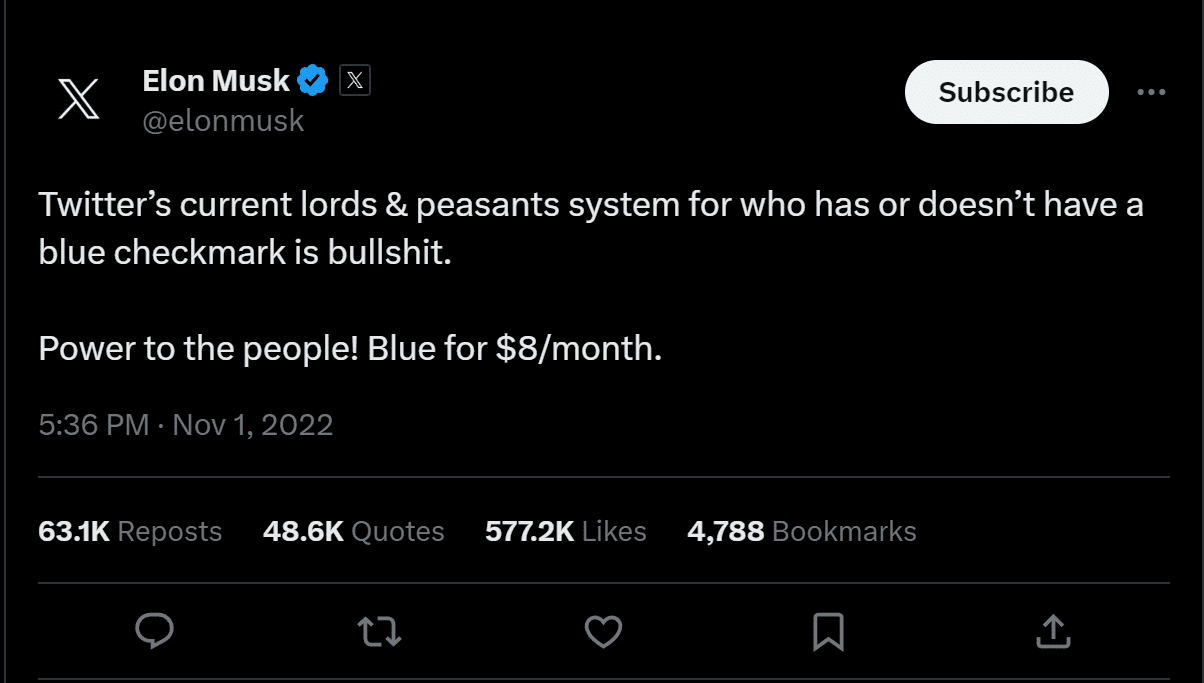
Musk changed the verification badge, allowing more users to receive a blue verification badge via Twitter Blue. Introduction of Twitter Blue charges – Photo by Walls.io on Unsplash
Enter ‘Twitter Blue’. Musk’s vision for Twitter Blue was to be able to give everyone the chance to gain an authentication badge. Many influential and prominent figures on the platform — that already had previously had verified status for free — were refusing to pay the $8 a month seemingly out of principle.
After a planned boycott, Musk decided to buy a bunch of outspoken celebrities refusing to support the new badge Twitter Blue access sending them into yet another rage. These changes to the verification process caused a lot of discussion and disagreement on the platform, with politicians weighing in on what they think of the changes. US representative, Alexandria Ocasio-Cortez, was one such person which resulted in Musk replying in a way that only Elon Musk could.
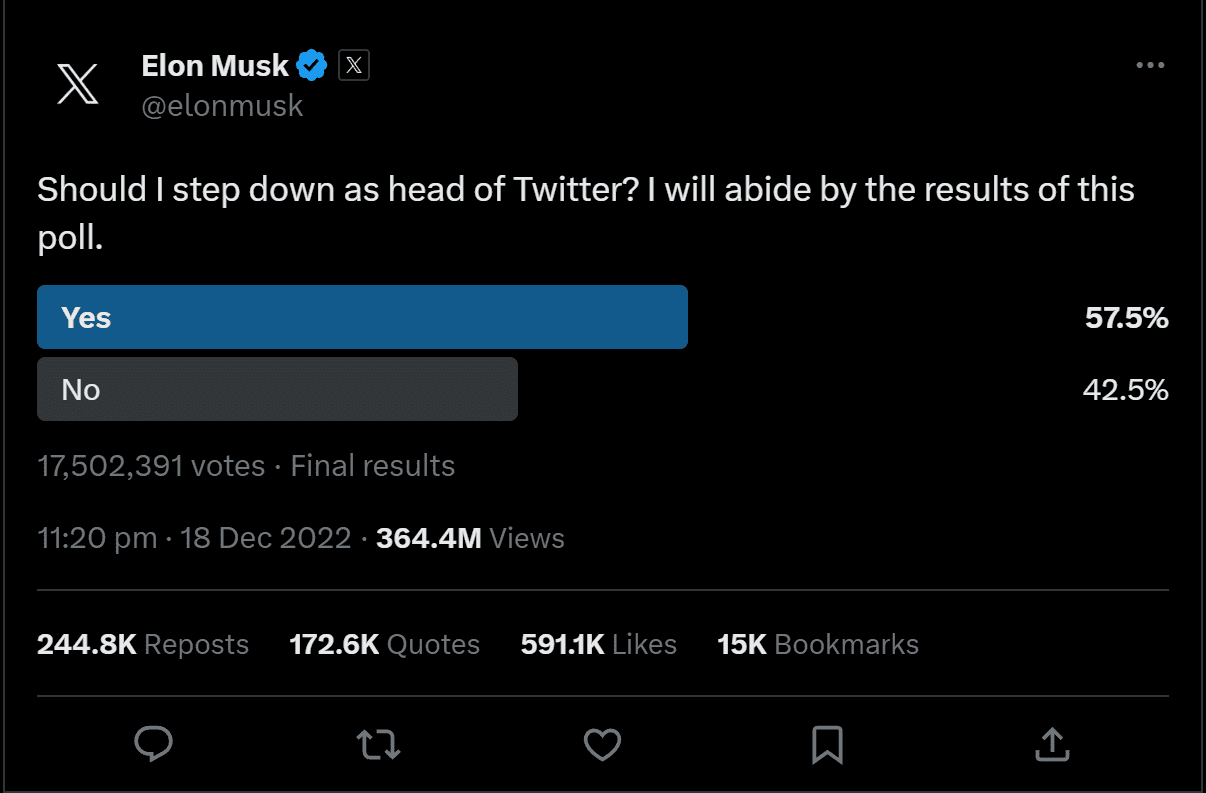
Twitter X Rebranding, Challenges and The Twitter’s Future: Elon Musk ran a poll on Twitter and promised to honour the results
There will undoubtedly be more changes ahead for Twitter Blue, but it’s clear that Musk wants to open the verification up to everyone in preparation for its version of Musk’s ‘everything app’ which we will cover later in the article.
There are some key differences between X premium and the free version of X. Here are the main differences in terms of what premium brings to the table. If the past few months are anything to go by, these features are subject to change frequently.
- Allows for early access to new features
- Edit your tweets
- Adds authentication checkmark
- See 50% fewer advertisements
- Prioritised rankings in search
- Post up to 25,000 characters
- Additional text formatting options
- Additional themes to choose from
- NFT profile pictures
It is worth noting that this is not to be confused with ‘Verified Organizations’ which is a separate verification process that is aimed at governments, institutions, and large businesses.
Twitter Premium was essential in securing much-needed revenue to ensure Twitter’s future under Musk. After making a huge number of staff cuts and rolling out new features in addition to hiring a new CEO, Musk hopes to win advertisers back as well as generate additional revenue for the platform. More on that later in the article.
Twitter Long-Form Content
We mentioned above that the premium tweet (or post) length has now increased to a massive 25,000 characters. Will this have huge implications for a platform that was created to keep posts short and concise? Or will it allow users to express themselves with more nuance and detail than ever before?
We think a better balance could be struck by having two versions of the same tweet for premium users. Users that exceed a basic character threshold could be asked, once finished, to post a shorter version optimised for 280 characters. This will always show the shorter version in the feed, but give users an option to click ‘more’ if they want to read a more comprehensive and in-depth post based on the same tweet.
Part of Twitter’s appeal has always been the short and concise nature of the posts, allowing for quick scrolling through posts that are stripped of all unnecessary bloat. As mentioned previously, this does come at a cost, but ultimately is a net positive for the user experience. It is still early days when it comes to X’s long-form potential, and only time will tell how many people will use the feature, and how effective it will be at engaging readers on the platform who are used to shorter micro-content.
Twitter X Rebranding & The Implications
As you likely know by now, Elon Musk recently completed a rebrand which transformed Twitter into X. What does this mean for the platform going forward, and what challenges will Musk face in attempting to realise his vision for X as a digital town square? What will the future of Twitter under Elon Musk look like?
Elon Musk’s Everything App (X App)
Elon Musk’s vision for the platform is bigger than just status updates and retweets — Musk plans to create somewhat of a ‘swiss army knife’ platform that has multiple uses. Similar to WeChat, (or Weixin in China) Musk wants to create an app that functions as a digital ID system that can be used to identify users and a platform to send money, invest, buy, and trade cryptocurrency and more.
Musk of All Trades, Master Of None?
It’s almost incomprehensible to fathom how Elon Musk has the time to run SpaceX, Tesla, X, The Boring Company and still have time to argue with politicians at the same time. Will the undertaking of building a ‘super app’ finally prove to be too much for Elon Musk?
Musk and X will have their work cut out for them in creating such an app that both complies with privacy laws and also has appeal for casual users. Let’s take a look at some of the biggest challenges Elon Musk and his team will face over the next few months at X, and into the future building their “everything app”.
Challenges for Elon Musk
There are seemingly endless challenges with just the logistical implementation of an “everything app”, but in addition, there are endless technical and legal challenges too. First, though, let’s focus on the challenges Musk will face at X in the coming months.
Ownership and Direction
Musk was recently replaced by Linda Yaccarino after running a Twitter poll asking users if he should step down as CEO. He is now exec chair and CTO, and will focus more on the systems rather than making impulsive and poorly thought-out changes to the platform. “I’m looking at you, Doge-themed Twitter“!

Elon Musk’s Twitter logo changes to Doge (Dogecoin), suggesting crypto tie-in?
This should give advertisers some of their confidence back after huge numbers were leaving the platform in droves after the news of Musk’s acquisition was announced.
There are still concerns amongst users though about the direction of the platform as we touched on earlier. Many worry that Musk’s anti-censorship stance in addition to reduced content moderation would allow for far-right extremism and fake news to thrive on the platform. However, Kanye West was banned on the platform under Musk’s leadership for 8 months due to his antisemitic tweets, proving that there still is sensible censorship on the platform when needed.
X Subscriptions Feature
Another new feature that has been added to the platform since the takeover is subscriptions. This is aimed at allowing creators to make money from their content while using the platform. This is done by allowing for exclusive posts and subscriber-only spaces that are only seen by subscribers, as well as a visible badge listed on the subscriber’s replies to the creator.
Creators currently have the option to choose from a price tier that they want their subscription to fall under and can earn 97% of the revenue from the subscription until the creator’s lifetime earnings have exceeded $50,000.
The subscription eligibility criteria has changed a few times, but currently, it is as follows.
- Creators must be 18 or over
- Minimum following of 500
- Active in the past 30 days
- Subscribe to Premium or Verified Organisations
This, like most things with X, is subject to change so it’s always worth visiting X’s support centre for the latest information on the exact requirements.
X’s Answer to AI, Grok
With fierce competition and innovation coming from other tech companies and rivals in the form of generative AI, Musk’s most recent announcement on 4th November 2023 is Grok, an AI chatbot with a sense of humour.
Announcing Grok!
Grok is an AI modeled after the Hitchhiker’s Guide to the Galaxy, so intended to answer almost anything and, far harder, even suggest what questions to ask!
Grok is designed to answer questions with a bit of wit and has a rebellious streak, so please don’t use…
— xAI (@xai) November 5, 2023
The name Grok means “understand”, a word invented in Robert Heinlein’s 1961 sci-fi novel, Stranger in a Strange Land.
With its wit, a rebellious streak, and the ability to gain real-time knowledge of the world through X, Grok aims to rival the likes of OpenAI’s ChatGPT, Microsoft’s Bing Chat, and Google’s Bard. At a glance, the in-built capacity of Grok to access truly real-time info using social media like this seems like a massive benefit and selling point for X.
Example of Grok vs typical GPT, where Grok has current information, but other doesn’t pic.twitter.com/hBRXmQ8KFi
— Elon Musk (@elonmusk) November 5, 2023
Still classed as a beta product, Grok is currently being trialled before release to the general public but users can currently join the waitlist by using their X account details.
The Growth of Twitter
It’s interesting when analysing what the public data has to say about the growth and potential decline of Twitter.
On the one hand, reports such as below from Statistica show that the number of monetisable daily active Twitter users (mDAU) worldwide is increasing, or at least up to Q3 of 2022.
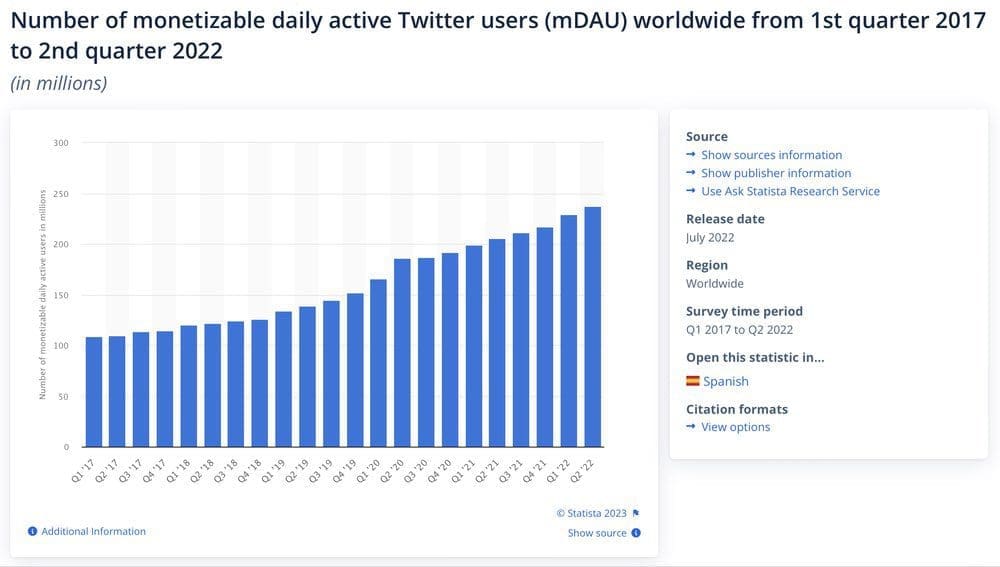
Monetizable daily active Twitter users (mDAU) shows an increasing trend between 2017 to 2022. Source – Statista.com
Elon Musk clearly wants us to believe this is the case, claiming that:
“X monthly users reach new high in 2023”
𝕏 monthly users reach new high in 2023 pic.twitter.com/trqLGBEvvA
— Elon Musk (@elonmusk) July 28, 2023
So this is great, right? The difficulty is that we see a different view when looking at other data.
The Decline of Twitter
Two further Statistica reports show a slightly different picture.
The chart below displays the total number of Twitter users worldwide and shows a gradual decline from 2022, which coincides with the year Musk purchased Twitter.

The number of Twitter users worldwide from 2022 to 2024 is declining. Source – Statistica
The below charts show the user growth rate in decline from 2020.
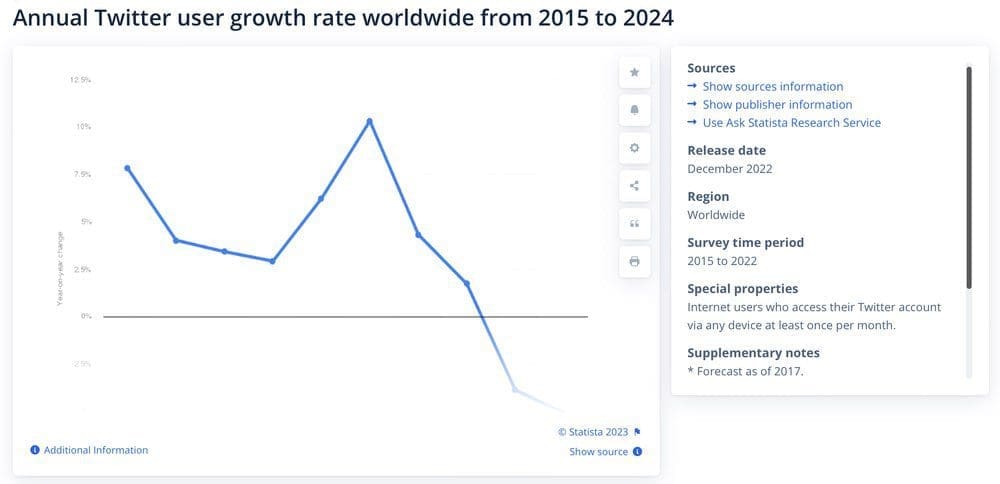
The annual Twitter growth rate is declining. Source – Statista.com
This seems to be backed up by other sources. In an article from Similarweb titled “Twitter is Shrinking: Web Visits Down 7.3%, App Usage Dropping“, we’re presented with two charts and an opening comment stating:
“Elon Musk claims Twitter is enjoying all-time high usage. We’re not seeing it.”
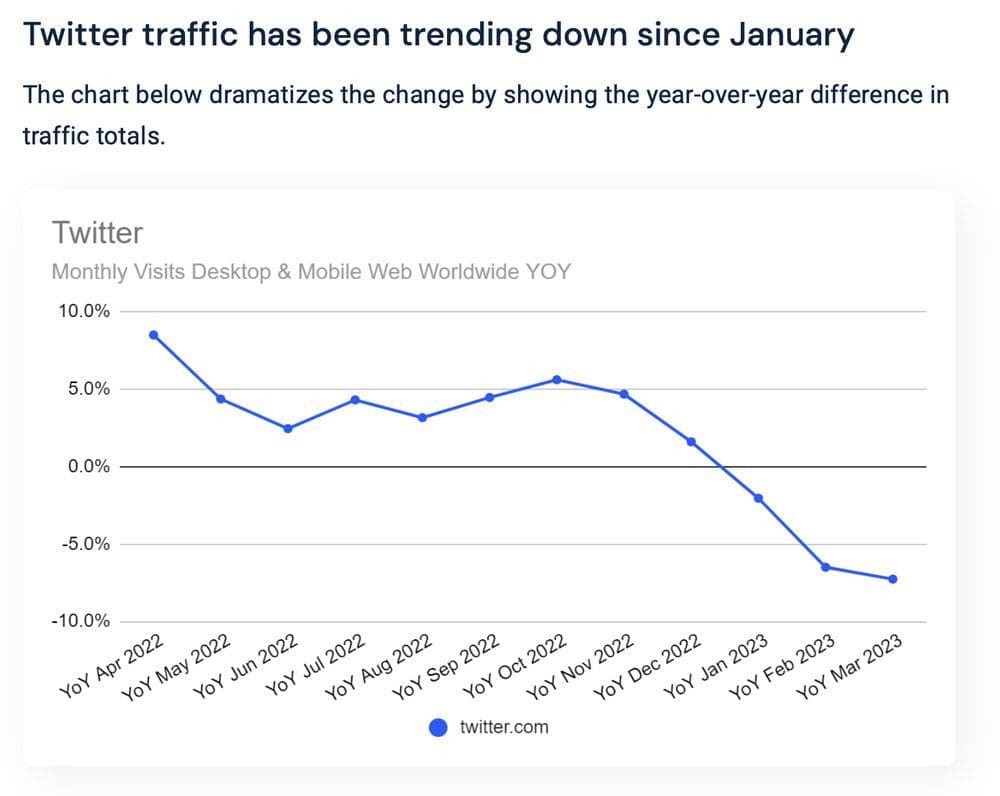
Twitter traffic has been trending down since January 2022. Source – Similarweb

Twitter app usage has been trending down since June 2021. Source – Similarweb
The decline of Twitter is also corroborated in the following article from The Guardian, which opens with the comment:
“Data shows the micro-blogging website has been shedding users since early 2023, not long after Elon Musk’s takeover.”
This comes following data from Cloudflare showing Twitter traffic taking, with The Guardian citing that users are leaving X in favour of alternative platforms such as Threads, BlueSky and Mastodon.
Twitter traffic tanking. https://t.co/KSIXqNsu40 pic.twitter.com/mLlbuXVR6r
— Matthew Prince 🌥 (@eastdakota) July 9, 2023
Worst Case Scenario For X (Decline & Eventual Death of Twitter)
Many celebrities and media outlets have a somewhat pessimistic general view when it comes to Twitter’s future as X, even calling the takeover ‘the death of Twitter’. Is this due to Musk’s contrary viewpoints relative to a lot of the mainstream narrative, or is Musk truly sending the platform in a nose-dive to bankruptcy?
If history has taught us anything, it’s that large technology companies aren’t too big to fail. The worst-case scenario is that advertisers refuse to return to the platform after their mass exodus. This would consequently force more staff cuts and perhaps mean more intrusive monetisation on the platform. In terms of what that monetisation would be is open to debate.
Also, a reduced emphasis on content moderation could potentially see X become synonymous with hate and potentially harmful viewpoints. This would lead to a deep decline of Twitter with many casual users leaving the platform.
Best Case Scenario For X (Twitter X Overtakes Facebook)
If anyone can prove naysayers wrong it’s Elon Musk. Despite all the odds being stacked against him, he still managed to play a key role in turning Tesla around from the brink of bankruptcy. He is no stranger to challenges and being told he’s making all the wrong choices by his critics.
The best-case scenario is that X continues to grow into a platform that can find a balance between free speech and moderation while still rooting out racism and hateful content.
The ambitious vision for Twitter’s future as X could see it take over Facebook as the go-to social network. It comes down to integration, adoption and useability. If Musk can realise his vision for his “everything app”, there will no doubt be downsides and failures along the way, but it could have a lot of great benefits for the average user.
Crypto integration is another feature that may propel X to new heights allowing for decentralised payments without relying on centralised banks. However, this is yet another careful balance as anonymous tokens without a public ledger can lead to facilitating the funding of illicit activities. We certainly hope to see Bitcoin integration at some point in the not-too-distant future.
Conclusion
Twitter’s history has been turbulent and is sure to have more challenges in the coming months and years as X. There is uncertainty surrounding whether or not it can continue to be profitable as a social media platform, that’s before even considering its potential as an ‘everything’ app.
Musk isn’t known for being a quitter and has many successes under his belt, so Opace for one are optimistic about the future of Twitter under Elon Musk and Linda Yaccarino’s leadership. Twitter’s rebranding to X is both smart and brave and the possibilities of X becoming an “everything app” are really quite exciting.
What do you think of Elon Musk’s takeover of Twitter? Do you think it will be a good thing or a bad thing for the future of the platform? As always, please let us know in the comments what you think — we read them all and try to engage with as many as possible.






0 Comments